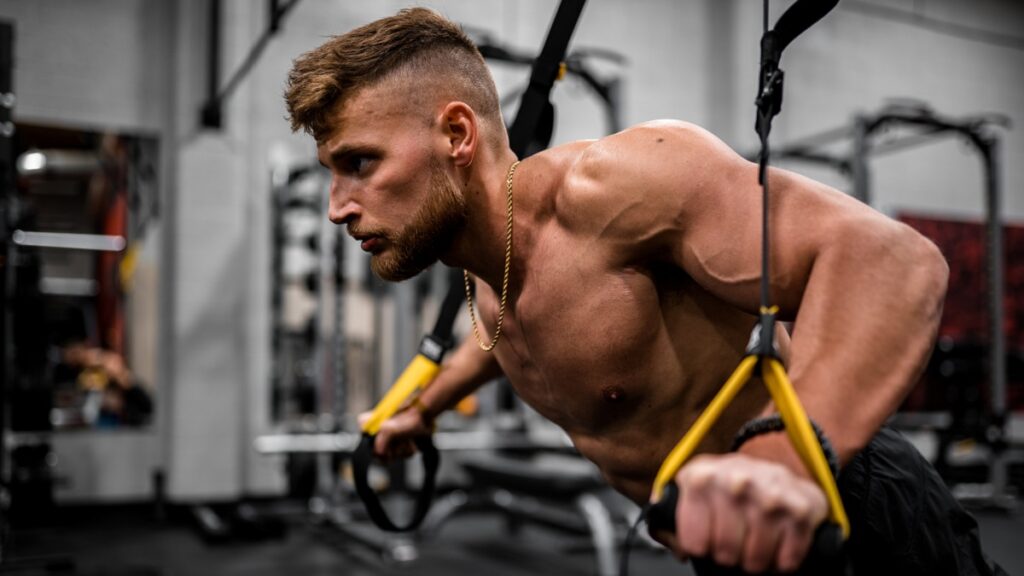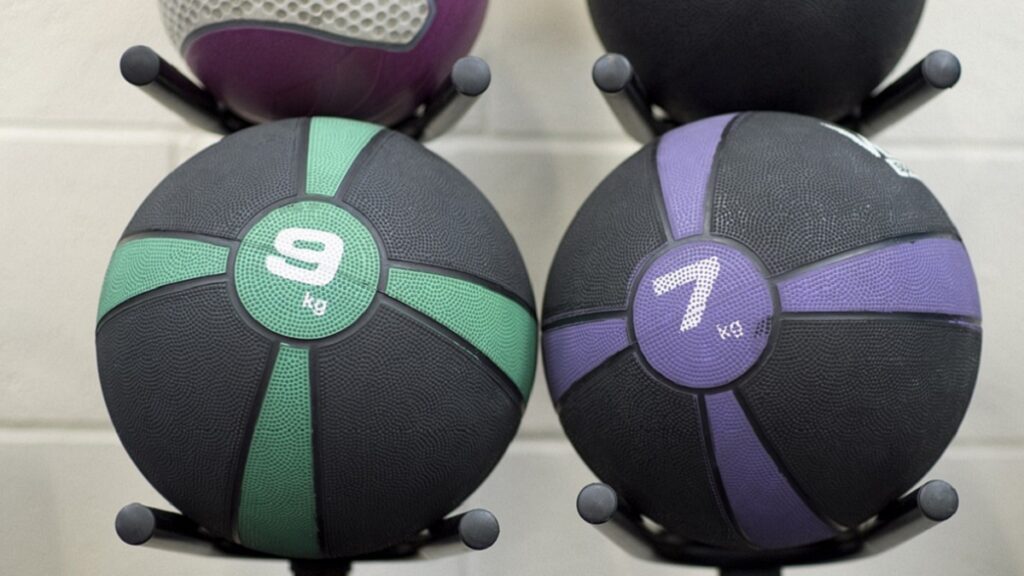Broad shoulders are a crucial component of an overall eye-catching physique. One of the best exercises for strengthening your shoulders is the overhead press. However, there are several situations where an alternative to shoulder press may be necessary.
For example, when you want to focus on a specific shoulder more than the other, when a barbell is not accessible, or when you want to add more variety to your workout.
Prowler push-up is the best alternative to shoulder press because it has fewer risks. You can also do landmine and Smith machine press exercises to broaden your shoulders. So you can quickly build them without shoulder presses. That helps you avoid straining your neck and shoulders too much.
To maximize your muscle development and avoid monotony, there are several excellent shoulder workouts that you may utilize in place of or in addition to the shoulder press.
The Best Alternative to Shoulder Press
A prowler push-up is the best alternative to shoulder press, especially for beginners. Additionally, it requires no equipment making it a go-to if you work out at the gym or at home. It also works out the deltoid muscles and carries fewer shoulder injury risks.
The fascinating push-up variation known as prowler push-ups includes a more noticeable stretch or eccentric component. Not to add, compared to other more complex push-up versions that target the shoulders, it’s more doable for many people.
The body should move forward during the exercise rather than only downward, stretching the front delts significantly and resulting in eccentric overload, which is essential for promoting muscular growth.
Of course, when you press your body backward, you also gain from the concentric phase.
- Put your feet together and get on your hands and toes. The distance between your hands and shoulders should be more expansive.
- When your front delts are sufficiently stretched, lift your knees off the floor and advance your body. Keep your shoulders stable and stay inside your comfort zone when moving forward.
- Shift forward and raise one knee to your elbow like Spiderman scaling a wall simultaneously.
- Stop when your butt is close to your heels and push yourself back while bringing the second leg back next to the other.
- Repeat the motion, but bring your other knee forward this time.
- Throughout the exercise, your knees should remain bent and a few inches above the ground.
What to Do If You Can’t Overhead Press?
You can do alternative exercises to tone your shoulders more easily and safely if you cannot do an overhead press.
Push-ups in Handstands
The handstand push-up is the most challenging dumbbell shoulder press barbell press substitute that comes to mind.
It entails doing precisely what it implies: pushing against your body weight upside down or in a handstand.
Your core muscles will get a good workout, and overall body stabilization will improve if you perform an unsupported handstand push-up without a wall.
However, if you must utilize a wall, you can do so. If you ever hope to reach that fitness level, this is also a perfect progression into the freestanding version. However, both can be very effective at developing muscular deltoids.
- Set up a mat or pad against a wall.
- Face the wall in a stance with your shoulders back.
- Put your hands on the floor about 6 inches from the wall, just outside shoulder width, and perform a handstand.
- Uplift your legs till your heel touches the wall. To keep your body as vertical as possible, contract your glutes and core.
- After deep breathing, bend your arms and lower your head toward the ground.
- Pause for 1-2 seconds after your head touches the mat or floor.
- Exhale as you straighten your arms and get back to the starting position by pushing through the palm of your hands.
Hold for 1–2 seconds at the top of each rep before continuing for the desired number of repetitions.
Landmine Press
The landmine setup is an incredibly effective training tool to develop full body functionality and stability, grow strength, create muscle mass, and increase coordination. It also comes top in the list of the best alternative to shoulder press workouts.
For people with shoulder mobility problems, it’s a fantastic alternative.
You can perform a kneeling press, standing press, two-arm press, one-arm press, and other variations. It’s an excellent option for variety, but owing to the movement’s nature, it still differs from performing other pressing actions.
- All you need for this exercise is a barbell. You can also use a landmine if you can access one, although it’s not required.
- Put one end of the barbell against a wall, landmine, or corner of a squat rack.
- Place the proper amount of weight on the barbell’s other end.
- Set up in a shoulder-width posture with your toes pointing out slightly. Reach down and take a neutral grip on the barbell’s end with your left hand.
- Lift the barbell’s end to your left shoulder. To align your body with the barbell’s course, lean slightly forward.
- Inhale deeply, tighten your abdominal muscles and raise the barbell until your arm is wholly stretched overhead.
- Exhale as you slowly lower the barbell back to your left shoulder after pausing at the top of the rep for one to two seconds.
- Repeat with a different arm after the desired number of repetitions.
Machine Press
Machines are a great way to exercise any muscle. That’s because many of them remove the stability from the action and let you concentrate just on overcoming resistance. That implies you can exercise hard and load on weights to enhance your muscles’ strength.
There are various variations of shoulder press-style equipment, depending on what your gym has. Some of them lock you into place, while others are made to provide you with more freedom of movement.
Using machines as a substitute for free-weight presses can be beneficial.
- So that the handles are at shoulder height, adjust the seat’s height.
- Choose or load the proper amount of weight for the machine.
- Place your feet firmly on the ground with the proper form before sitting on the machine, then reach up and gently grasp the grips neutrally. Your elbows and upper arms should form a 90-degree angle.
- Bring your chest up while slightly arching your back. As you move the weight upward, avoid letting your back arch excessively.
- Press the handles directly overhead by extending your arms after deep breathing and bracing your core.
- Exhale as you lower the handles back to the beginning position after pausing for 1-2 seconds at the peak of each repetition.
- The appropriate number of times should be repeated.
Smith Machine Press
If your mobility allows you to accomplish it, the Smith machine press is just one of those exercises that feels fantastic. You are free to add more weight since the predetermined course of the bar movement allows you to concentrate on the press rather than balancing or stabilizing additional weight.
The single-arm Smith machine press is a variant that few people have used.
The two-arm variant, however, doesn’t allow you to slant your body in any way.
Many exercisers discover that it feels more natural and better when they lean toward the bar.
Remaining tight and avoiding going too far down are two things to remember because they can lead to harm.
- You’ll need a Smith machine and an adjustable bench to perform this exercise.
- The bench should be positioned in the center of the Smith machine and set to the steepest slope. Attempt to keep your torso as straight as you can.
- As you position the bench, the bar path should be immediately before you. Have the Smith machine bar in its place so that you may unrack it safely while bending your elbows just a little bit. Fill each side with the proper amount of weight.
- Put your feet on the bench, raise your arms above your head, and grasp the bar with your shoulders (palms facing out). Put your head, back, and lower body against the cushion while slightly arching your lower back.
- Depending on the machine, lifting a little higher and moving the bar forward or backward will unrack the bar.
- Start lowering the bar near the top of your chest after taking a long breath.
- Pause for 1-2 seconds once your upper arm and elbow have reached a 90-degree angle.
- To maintain shoulder stability, exhale as you raise the bar overhead and halt just before lockout.
- The appropriate number of times should be repeated.
Bottoms-Up Kettlebell Press
Only a few exercises can match appropriate kettlebell training for balance, coordination, function, and general fitness. Due to the weight and handle design, the shape of the weight offers a challenge that other training programs and equipment do not. Consequently, it’s also among the best alternative to shoulder press workouts.
You must balance the weight above the handle and press the kettlebell instead of holding the handle while the weight hangs below!
As a result, if you’ve never done it before, you’ll need to start lighter than anticipated to get the grip and movement down.
However, the best alternative to shoulder press exercise is only advised for people with some resistance training experience.
Additionally, you should be able to swing a kettlebell to position yourself and occasionally reset.
To perform the exercise:
- Swing the kettlebell into place at shoulder level while holding it in one hand. Maintain your front elbow position.
- Wait a moment to collect yourself.
- Press the kettlebell squarely overhead while battling to stay balanced while keeping it near your center of mass.
- Before switching arms, lower the weight while keeping your elbow close to your body and repeat for the desired reps.
- Unlike most everyday motions, you must maintain stability and balance to complete this workout. You might make mistakes occasionally. It’s alright; just raise the kettlebell again after swinging it between your legs.
- Swings can be used for every rep, or you can do presses by lowering the weight to shoulder level after each one.
Can I Skip the Shoulder Press?
You can skip the exercise and go for the best alternative to shoulder press for better results on your shoulders. The overhead press, also called the military press, sculpts the torso with amazing detail and is an excellent workout for the anterior deltoid.
Since flexion affects the serratus more than abduction, it works best in front. The front of the posterior deltoid responds well to a behind the neck overhead press.
Nevertheless, it has drawbacks that draw more alternatives in your shoulder building. Here are some reasons you’ll choose to shoulder press.
The Lower Back May Develop Problems
The body tries to use as much muscle as possible for any action. Your overhead press will also try to change into a bench press. As the weight increases, this results in the spine’s hyper-extending.
Any movement of the lower back while carrying a burden puts it at risk for severe damage.
Your body can achieve the position it aspires to use the bench press.
Less Muscle is Involved
According to some, the overhead press balances the shoulder’s anterior. That happens if there is a horizontal push and pull. These also exert more muscle, which has additional advantages, including the indirect effect of improving hormones.
As long as you avoid using too much range of motion, which is the primary cause of difficulties with the bench press, they are also considerably safer.
Might Strain the Active Muscles
The front of the shoulder and upper chest may serve as a shelf for the barbell during overhead lifts. The muscles that are in use are compressed, which could harm them.
It doesn’t always follow that you should do it with a weight just because you can raise your hand aloft. Many muscles have only been able to hold postures or move quickly. Anything less will be against what your body anticipates.
Excessive External Joint Twisting
Generally, the safe range is from the level position, downward about 45 vast degrees, and upward about 70 degrees. That varies a little from person to person, depending on the amount of shoulder joint flexibility.
So, to complete an overhead press, you must rotate your shoulders 90 degrees into the unsafe zone before adding resistance when the shoulders have reached their maximum mechanical stress.
Can You Build Shoulders Without Presses?
Yes, you can have big shoulders without doing overhead presses. Although overhead presses can be used for huge and broad shoulders, they are a massive threat if you haven’t trained properly. This is probably why most people advocate for the best alternative to shoulder press exercises.
So, before moving anything heavy-weight overhead, ensure you know proper overhead mechanics.
The overhead press is a terrific carryover exercise for athletes who need strength in the overhead position and for other overhead lifts in the gym. It enhances upper body flex appeal, power, and strength.
Why Can’t I Do a Shoulder Press?
It can be interesting to do push shoulder presses, but this isn’t the case for most beginners who haven’t developed a strong upper back and defined shoulders. Heavyweight bodybuilders also use it to measure their strength. Therefore, it may be difficult for beginners.
Olympic weightlifters, for example, need to use it to prepare for competition. Not everyone would benefit from it because of their particular requirements, though.
Even though you might be fortunate and avoid injury, using the overhead press still involves danger. Overuse can result in injury, not simply a sudden event. Your shoulders may already have suffered damage over time.
Why Should You Not Overhead Press?
It’s challenging to embrace the idea that overhead presses, exercises that have been around for years and have long been regarded as essential in weight training, may not be as effective as once thought. Such an idea is absurd!
It could put too much strain on your neck and shoulders; it’s also one of the fitness industry’s most contentious workouts.
Although it’s safe to perform the activity, not everyone should. To keep safe, even experienced lifters should work with a personal trainer or embrace the overhead press alternatives.
How to Do Shoulder Presses at Home?
You can do the overhead press at home with no equipment. Bring your ribs in a standing position with your feet at hip width and your legs straight. Then, with your elbows out to the sides and at shoulder height, make fists with your hands and raise them above your shoulders.
Keep your body supported and press your hands above your head when your arms are straight above each shoulder. Repeat pressing back up to the top while bending your elbows to return your hands to the starting position for the remainder of the exercise.
Leaning back during this exercise is a standard error since your shoulders, pecs, and lats may be tight. Avoid doing this since it can strain your lower back. You can make yourself stand straight by placing your back against a wall.
Is Overhead Press Necessary?
Although the overhead press is a powerful muscle and strength-building exercise, shoulder hypertrophy can be achieved without it. You will effectively target the side and front delts if you push vertically (for example, machine shoulder press).
To efficiently target all three heads of the delts, isolation exercises are a great option in addition to vertical pressing. Whatever exercise you do, concentrate on honing your form, sensing the muscles contract, and gradually increasing the weight and reps. Strength and muscle mass can be increased by progressive loading.
What Can I Substitute for Shoulder press?
A good shoulder press substitute should involve some press and target the same muscles. The front, side, and a small portion of the back deltoids are included.
The three deltoid heads you focus on during the press alternative depend on how you hold your arms.
For instance, you’ll emphasize more of the front deltoid if you hold your arms out in front of your body like many of these finest shoulder press alternatives.
However, if your arms are extended sideways to your body with your elbows pointed out, you’ll strike much of the side deltoid. Unlike the previous example, all three heads will likely be activated equally.
We have the best alternatives to press, but you should figure out which suits you best. The most crucial thing is ensuring all deltoid heads receive equal training by integrating isolated exercises like lateral raises and rear delts workouts.
FAQs
How Do You Do A Shoulder Press Without Weight?
Handstand push-ups are a way to complete a shoulder press without using weights. You can also execute a resistance band shoulder press if you have one; this is a more approachable workout for most individuals.
Is There an Alternative to Overhead Press?
You might perform the landmine, machine, and handstand push press instead of the overhead press. Like the overhead press, each exercise targets the shoulder blades.
Bottom Line
For a good reason, the overhead press is a popular workout among gym goers. The shoulder muscles are among several muscle groups the overhead press targets. It works particularly well at boosting shoulder growth and strength while enhancing stability.
The overhead press is not a required workout, despite being a very effective exercise. Several shoulder exercises work better as an alternative to shoulder presses because it’s risky or if you want to break the boredom in the gym.



